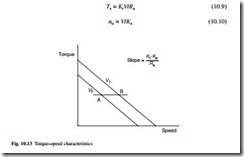The brushless servomotor
A synchronous machine with permanent magnets on the rotor is the heart of the modern brushless servomotor drive. The motor stays in synchronism with the frequency of supply, though there is a limit to the maximum torque which can be developed before the rotor is forced out of synchronism, pull-out torque being typically between 1.5 and 4 times the continuously rated torque. The torque–speed curve is therefore simply a vertical line.
The industrial application of brushless servomotors has grown significantly for the following reasons:
● reduction of price of power conversion products
● establishment of advanced control of PWM inverters
● development of new, more powerful and easier to use permanent magnet materials
● the developing need for highly accurate position control
● the manufacture of all these components in a very compact form
They are, in principle, easy to control because the torque is generated in proportion to the current. In addition, they have high efficiency, and high dynamic responses can be achieved.
Brushless servomotors are often called brushless dc servomotors because their structure is different from that of dc servomotors. They rectify current by means of transistor switching within the associated drive or amplifier, instead of a commutator as used in dc servomotors. Confusingly, they are also called ac servomotors because brushless servo- motors of the synchronous type (with a permanent magnet rotor) detect the position of the rotational magnetic field to control the three-phase current of the armature. It is now widely recognized that brushless ac refers to a motor with a sinusoidal stator winding distribution which is designed for use on a sinusoidal or PWM inverter supply voltage. Brushless dc refers to a motor with a trapezoidal stator winding distribution which is designed for use on a square wave or block commutation inverter supply voltage.
The brushless servomotor lacks the commutator of the dc motor, and has a device (the drive, sometimes referred to as the amplifier) for making the current flow according to the rotor position. In the dc motor, increasing the number of commutator segments reduces torque variation. In the brushless motor, torque variation is reduced by making the coil three-phase and, in the steady state, by controlling the current of each phase into a sine wave.
Stationary torque characteristics
The simple equivalent circuit of Fig. 10.12 represents a motor which uses permanent magnets to supply the field flux. This is a series circuit comprising the armature resistance Ra, and back emf E. If the voltage drop across the transistors is ignored, the equation for the voltage is
Kt is known as the torque constant of the motor.
Figure 10.13 shows the relation between T and n at two different voltages. The torque decreases linearly as the speed increases and the slope is KtKe /Ra which is independent of the terminal voltage and the speed. Such characteristics make speed or position control relatively easy.
The starting torque and the speed are given by
In modern drive systems, a flux vector controller is applied to many brushless servomotors. The control is almost exactly as for the induction motor except zero flux-producing current is demanded for operation in the normal frequency range.


